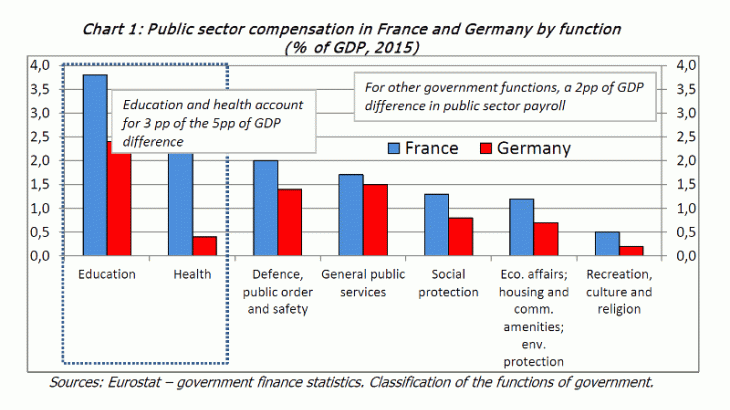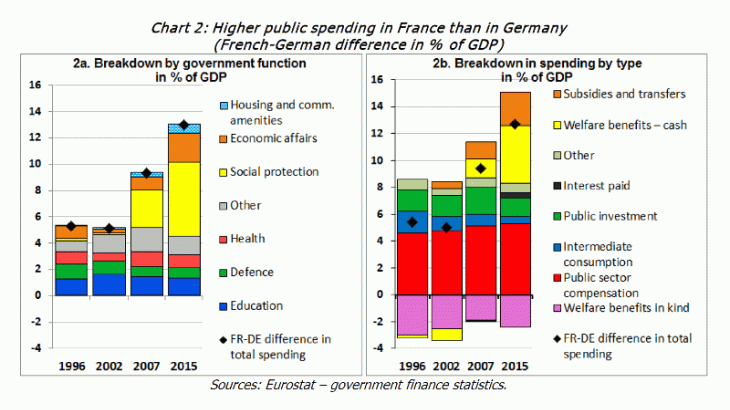Public sector payroll: a significant difference, but partly overestimated
The breakdown of spending by type shows a significant difference in payroll, which is quasi-constant over time at more than five percentage points of GDP (see Chart 2b). In 2015, public sector compensation represented 12.9% of GDP in France compared with 7.5% in Germany. This difference is linked to the number of employees, of which there are 6 million, representing 22% of total employment, in France based on the national accounts concept of civil employment (a broader notion than the civil service, under which the economic criterion related to financing is applied) compared with 4.7 million, or 11% of total employment, in Germany. Cross-checking with the breakdown by government function shows that the higher public sector compensation in France concerns every area of government intervention (see Chart 1).
Several factors should be taken into consideration when analysing these differences. For example, to all appearances, outsourcing or the use of sub-contractors reduces payroll expenses, but they remain a cost to the government. Furthermore, certain accounting classifications (see below) can complicate comparisons between France and Germany.
60% of the difference in health and education spending is easily explained
In France, almost half of the public sector payroll goes on the health and education sectors, which account for 60% of the difference between France and Germany.
Although public spending on health in the two countries is relatively similar, in France almost 30% of that expenditure is allocated to employee compensation (mainly hospital workers), whereas in Germany this proportion is far lower, at 6%. This is due to the accounting classification of public hospitals in Germany, where they are categorised as non-financial corporations in the German national accounts because under the German price system hospitals are classed as market producers. This accounting treatment is reflected in the breakdown of spending by type, with a larger payroll in France but more benefits in kind in Germany. In reality, German hospital expenditure is still largely accounted for under public spending through public financing (subsidies or transfers to the hospitals) and due to the costs of hospital treatment being borne by the public health insurance system (social transfers in kind). When hospital expenditure is corrected for these accounting inconsistencies, the difference in the public sector payroll is reduced by around two percentage points of GDP.
In terms of education, wages make up a significant proportion of public spending. In France, which has a younger population and a differently organised pre-primary system, higher spending on education is inevitable (see Rue de la Banque No. 46). In addition, Germany relies more heavily on outsourcing, which is reflected in the accounts by a more substantial proportion of intermediate consumption.
A residual difference in spending of two percentage points of GDP for each of the other government functions
Even after taking into consideration the corrections mentioned above, Germany, with fewer public sector employees, spends less on its public sector payroll than France.
Comparing public sector employees based on the NACE statistical classifications of economic activities in the European Union confirms this difference, beyond institutional status and excluding health and education. Section O (Public administration and defence; compulsory social security), notably includes general public administration, defence, justice and judicial activities, and the police (including any private bodies if they are responsible for typical public administration activities). Based on this classification, public administration employment in 2015 represented 9% of total employment in France and 7% in Germany.
In conclusion, out of all the comparisons between France and Germany, it should be noted that there is a persistent difference in public sector payroll spending related to the size of the workforce, even if the difference is less significant than the gross figures suggest. As reducing the number of public employees in France is a major issue in the debate on controlling public spending, a lucid assessment of these comparisons, particularly with Germany, is essential.

